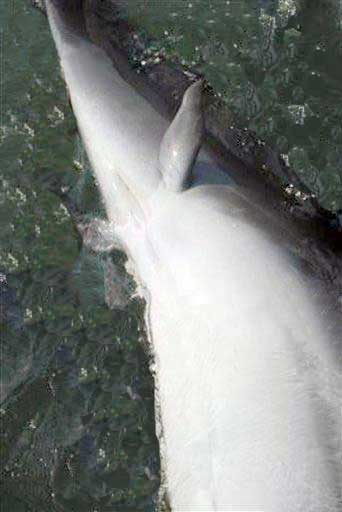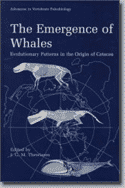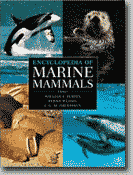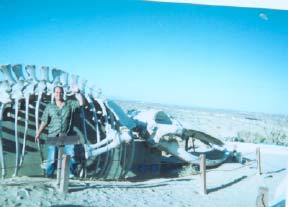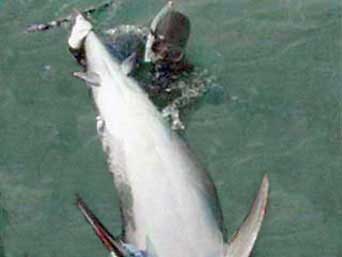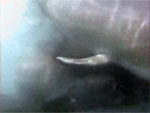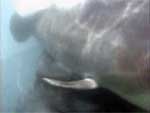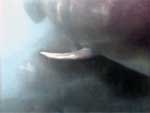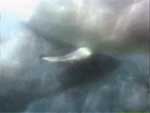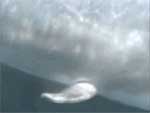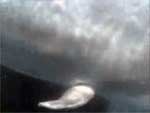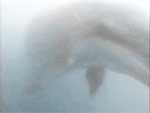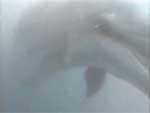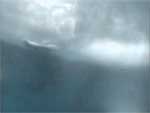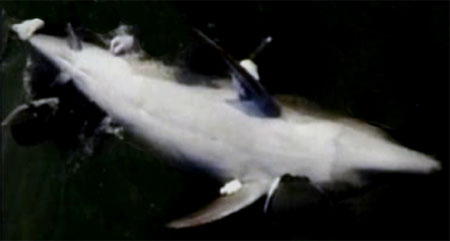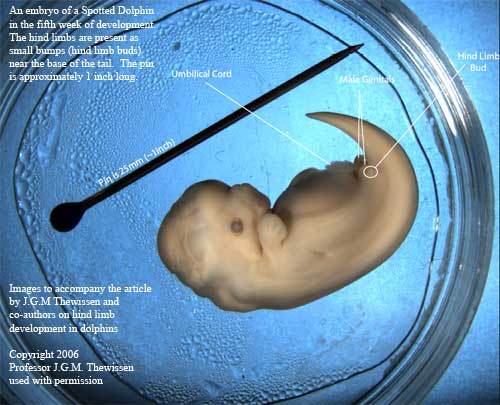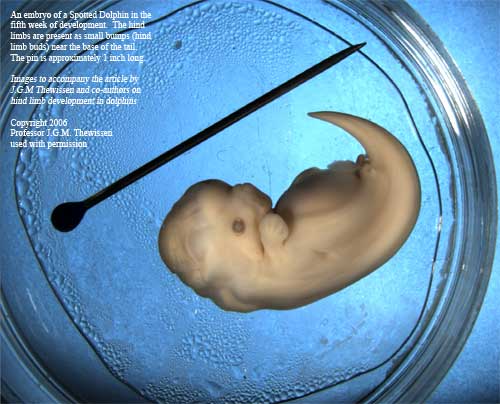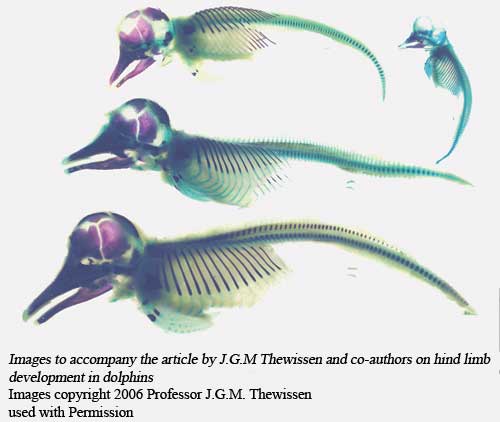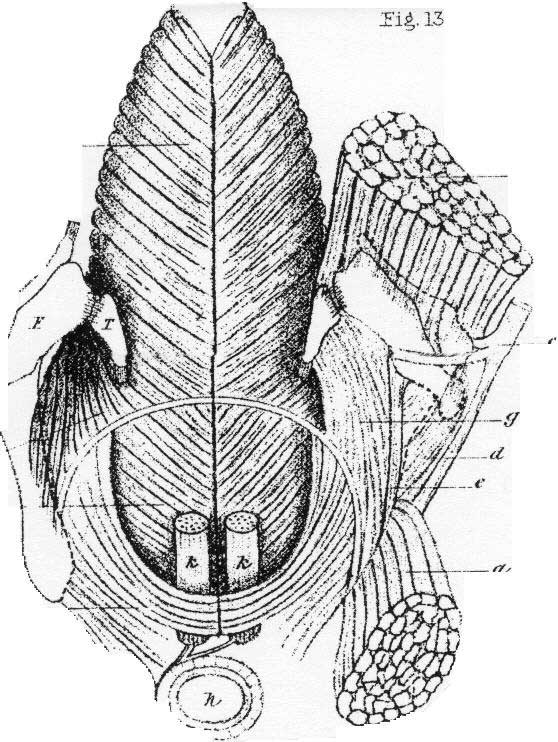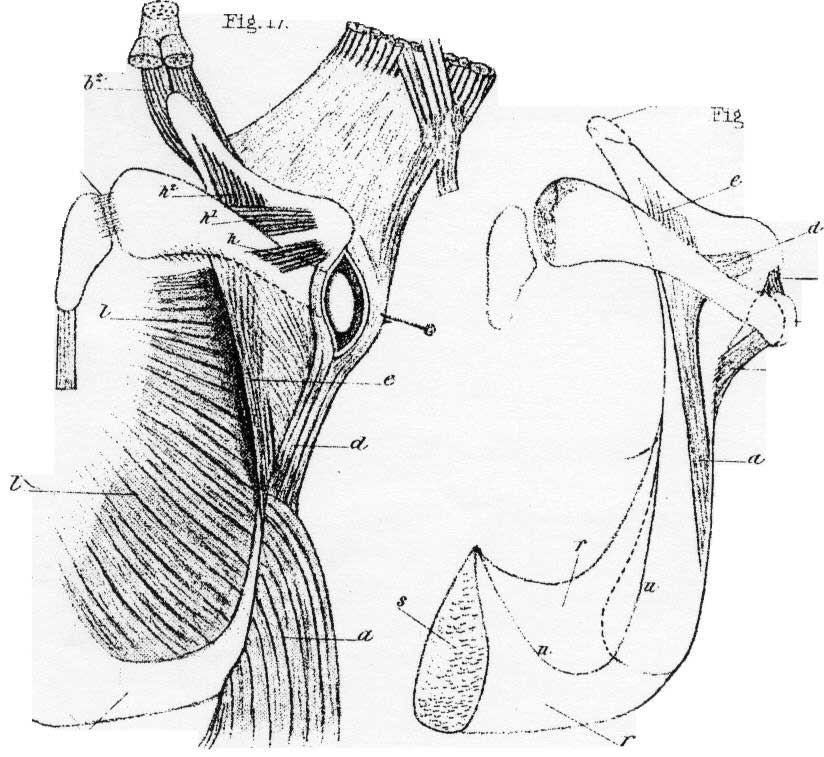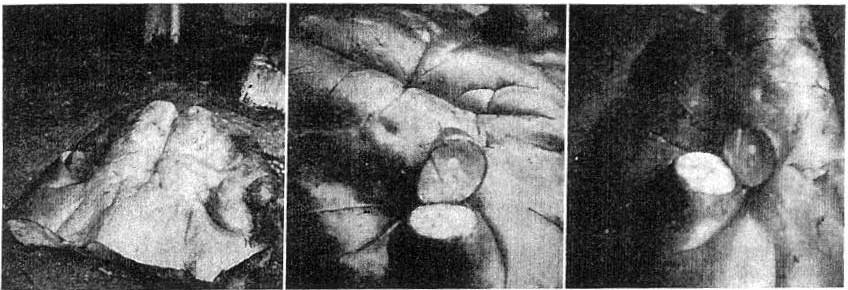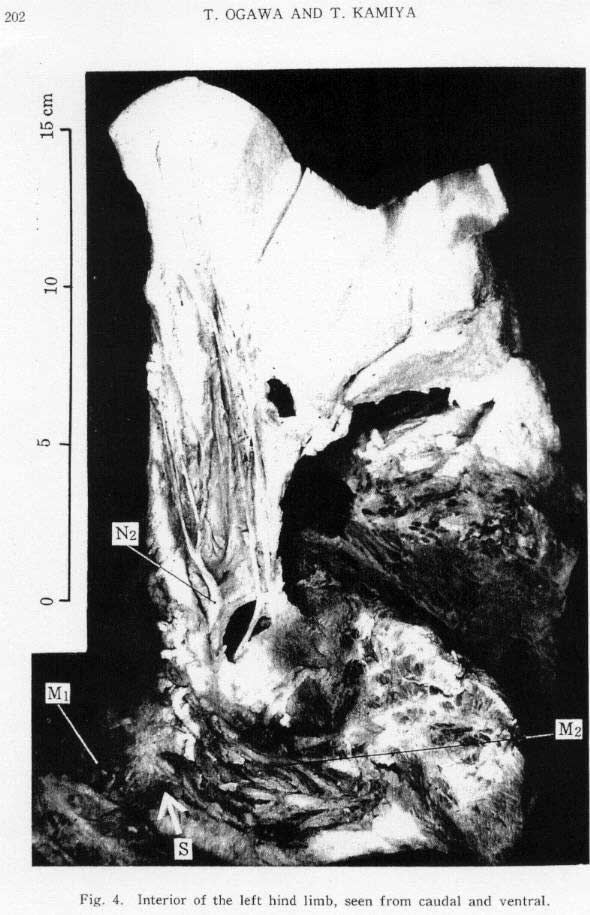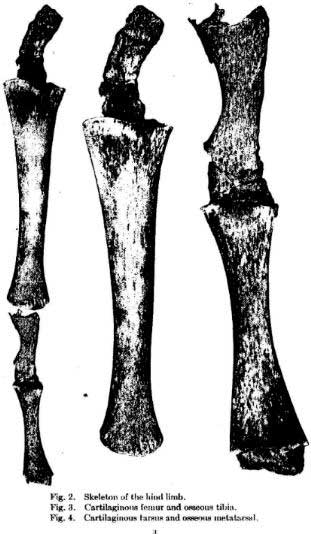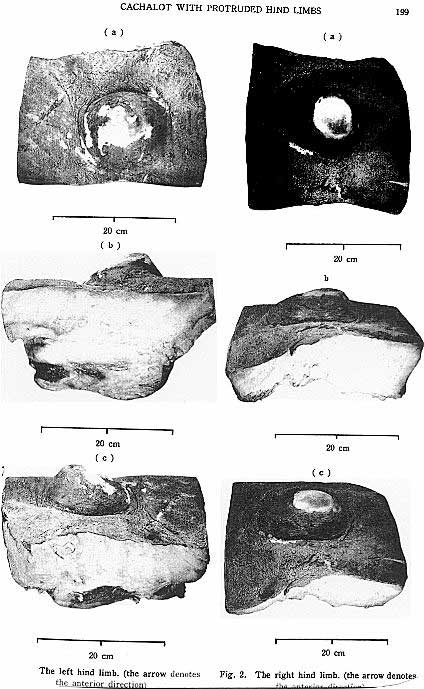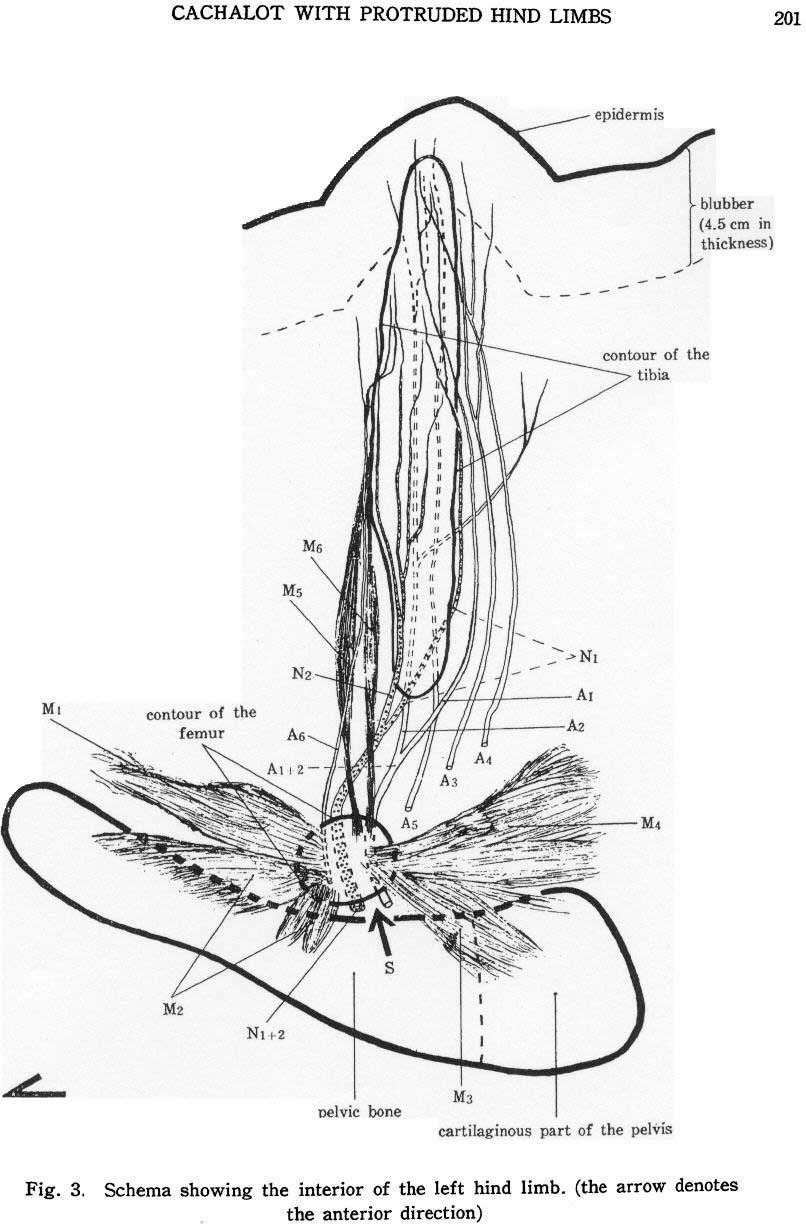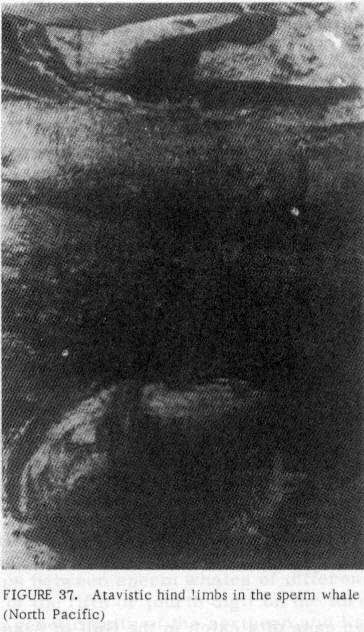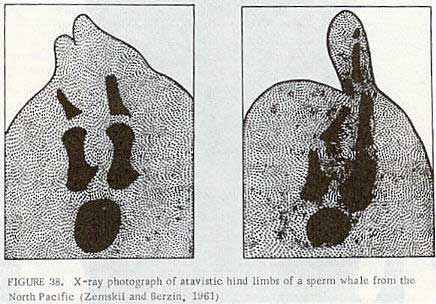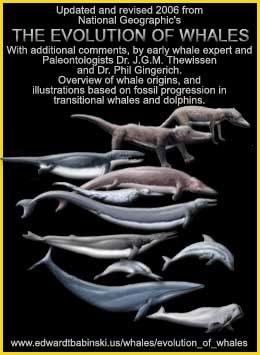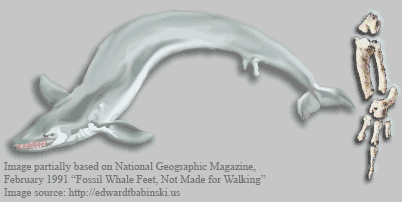Cetacean Evolution (Whales, Dolphins, Porpoises)
Evidence Of Common Ancestry of Cetaceans and Certain Species of Land Mammals
by Edward T. Babinski
ANSWERS IN GENESIS: AMBULOCETUS' MISSING PELVIC GIRDLE? ...BACKBONE? LEG BONES?
Ed Babinski's Reply to Answers in Genesis
The question of "who said what, and when," will be forgotten as time goes on, and hence it is not quite as important as the question of what the evidence for cetcean evolution means. If Sarfati can't even acknowledge that evidence for evolution exists, then pointing out dates to him of what he said and when he said it, isn't going to change his mind on evolution. And even though he spoke hastily about the pelvis not being there in that fossil, he can always write a new article about the latest evidence and include mention of the pelvis but deny that it means anything in his opinion, hence, denial after denial. Fact is, AiG is horrible at seeking out information. After being told about scientists discovering hind leg rudiments on modern day whales, they failed to seek for the original scientific articles, even after exact references were given to them, instead posting a pic of a diseased whale skeleton. They didn't even want to obtain the articles about whale hind-leg rudiments from Interlibrary loan, because the references for such article were posted on a site run by "talk origins," and they categorize everything at that site as lies. And when I obtained the actual articles and posted the pics and info online, Sarfati continued to deny that such sources meant anything, and he mocked me and my website. I'm not sure he even looked at the info. He is a preacher damning other people eternally for not agreeing with him. He truly fears evolution more than I fear his "hell for non-born agains."
AiG's website "A Whale of a Tale, Addendum" 2 (4 January 2002)") admits that the original article in which they criticized the fossil evidence for cetacean evolution was merely based on discoveries reported at the time the original AiG article was written. And AiG questioned whether the latest cetacean fossil discoveries had been peer reviewed, or whether the new evidence was anything more than a jumble of bones. For young-earth creationists it's the same method of denial in every case, harkening back to the days of Gish at ICR. Take primate evolution. We have primate skulls with cranial capacities lying between higher apes and human beings, skulls whose pedigrees even creationists can't agree on, are they the skulls of "apes or men?" Creationists can't agree which skulls belong to which category. How inspiring! Still, they are not going to admit that ANY evidence for the transformation of living organisms over time is the least bit "clear." Perhaps if you could point a young-earth creationist to a geological deposit in which one species of animal died directly on top of its daddy/mommy, and that pattern continued indefinitely so you could catalog evolutionary changes without a single "gap," they would take note. Though some would probably assert instead instead that the Flood had miraculous sorting properties. What they neglect is a sense of proportion regarding geology and paleontology. Cetacean fossils are not found everywhere in the fossil record, but only in specific places. In fact the geological records as a whole exhibits sorting to a far greater degree than "Flood geology" can account for. Fossils (from the most microscopic fossils to large plant fossils to fossil fragments to "trace" fossils to large complete fossilized organisms) are found in astonishingly accurate relative orders around the world, and exhibit a degree of relative sorting such that geologists before Darwin's day were doubtful any "Flood" could sort things in such a fashion. Young-earth creationists are still only beginning to come to grips with their own "Piltdown and Nebraska man" type errors of enthusiasm, and yet they have uncovered no new startling evidence to replace the formerly enshrined "Paluxy mantracks" or the "sightings of Noah's Ark" (the mountain on which Noah's Ark searchers have concentrated their past searches is a mountain that was formed volcanically! Mustta been pretty hot when Noah got there, and its elevation hard to breath, and sides steep and dangerous). Snelling at AiG even despairs of finding the ark on Ararat and despairs that any unequivocal evidence of "pre-Flood man" or his dwellings or tools or other creations may ever be discovered in the geological record, though we do find plenty of what he calls "pre-Flood" animal and plant remains.
Of course if young-earth creationists took the time, they might learn to recognize why geologists are not wowed by "evidences of a young-earth," and might even learn to recognize the distinguishing differences displayed in earlier forms of fossilized organisms when compared with later ones, and see for themselves that various specializations did not all occur early on, and in fact the earlier species of cetaceans resembled land animals more than later cetaceans did, and the ealier forms of cetaceans were less well adapted to living their entire lives at sea than the more recent forms are. But since they can't even get past the fact that the geological layers are not as mixed up as their "Flood geology hypotheses" assumes, how do you intend for them to also recognize the telltale differences between early, mid, and modern cetacean species, and notice the lack of specialization of the earlier species compared with later ones?
Neither do they see any need to understand such matters, since they "understand" Genesis just fine, and they are certain that is all they really need to know, i.e., how to count up to "six days."
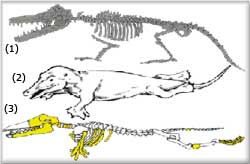
Image based on the image located on AiG, as is on Dec. 02, 2004 compared to image based on a photo image (below) featured in a November 2001 copy of National Geographic, "The Evolution of Whales".
The author explains the three images:
1) Top: Ambulocetus skeleton, as drawn in Miller’s book
2) Middle: Ambulocetus reconstruction, as drawn in Miller‘s book
3) Bottom: Actual bones found (Yellow). Note missing pelvic girdle.
The question that comes to mind is if this was a deliberate attempt to mislead AiG readers, or simply an oversight due to negligence on behalf of Dr. Jonathan Sarfati? The fossil certainly does include backbone, leg bones, and pelvic bones. As is noted in the paraphrased excerpt below from National Geographic, Professor Hans Thewissen was discussing the spine of Ambulocetus as early as 1994, it would seem Answers in Genesis would be aware of this fact, ten years later.
Dr. Jonathan Sarfati:
On p. 265, Miller claimed, ‘the animal could move easily both on land and in water’, and contained a drawing of a complete skeleton and a reconstructed animal. But this is misleading, bordering on deceitful, and indicative of Miller’s unreliability, because there was no indication of the fact that far fewer bones were actually found than appear in his diagram. Crucially, the all-important pelvic girdle was not found (see diagram, right). Without this, it’s presumptuous for Miller to make that proclamation.
Below is an image based upon an actual photograph of an Ambulocetus fossil.
Note the presence of a pelvic region, including spine and leg bones which were all ommitted from Answers in Genesis sketch.
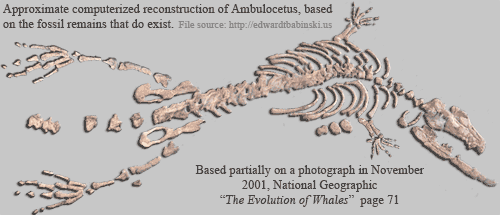
Ambulocetus natans as it is called, is currently the eldest known saltwater cetacean, according to National Geographic, page 72, November 2001 "The Evolution of Whales". Professor Hans Thewissen is quoted as saying, "With long hind legs and hands, but the teeth and ears of a more modern whale, this animal was on the fence between land and sea."
In a May 1994 issue of National Geographic, it reports the find of Ambulocetus in a former inland sea of Pakistan. Thewissen dubbed the ancient whale fossil Ambulocetus natans for "swimming, walking whale". He explains, on land it would lumber like a sea lion, and "it would look clumsy, but it could still get around." His team recovered much of the fossil including a skull which identified the fossil as a cetacean. The spine indicates the creature moved in similar fashion to modern whales, using its lower back in an up and down motion, while using its hind limbs for propulsion. It's forelimbs are believed to have been used for steering.
Judging excerpts from the article, one can safely deduce Jonathan Sarfati had never actually seen the fossil for himself[?]
Dr. Sarfati really should update his information on occasion.
How long has the information been available to scientists on the fossilized pelvis bones of Ambulocetus?
I was in question why Dr. Jonathan Sarfati does not have current information available on the Answers in Genesis website. I contacted Professor Hans Thewissen to verify exactly when the pelvis bones were discovered and knowledge about them dispersed to scientific circles? Should not have Jonathan Sarfati known about these pelvis bones earlier than the year 2004? If he has had knowledge, then I ask why has he neglected to update his web page?
To: Professor Hans Thewissen
Thursday, December 02, 2004
Question on Ambulocetus Discovery
Dear Professor Thewissen,
When exactly was the spine, the leg bones, the pelvic girdle discovered of Ambulocetus?
This morning I decided to take a look at Answers In Genesis where Dr. Jonathan Sarfati is arguing against the PBS Special #2 "Evolution:Great Transformations".
Dr. Sarfati is saying there is no spine, no pelvic bones, no leg bones -- and you were discussing the spine of Ambulocetus as early as 1994, and I have a reconstructed photo image of the Ambulocetus -- which appear to be very much complete! Where he got his information is questionable -- and I suspect he has never seen this fossil.
Thank you sincerely for your time
From: J. G. M. Thewissen
Sent: Thursday, December 02, 2004
Re: Question on Ambulocetus Discovery
The specimen was dug up in two phases, results from the first were published in 1994, results from the second in 1996. In 1994, we described some vertebrae, most leg bones, but no pelvis. In 1996, we described many more vertebrae, as well as the pelvis. So inferences about the spine in 1994 were based on the vertebrae we had then. The figure we published in 1994 shows, in stippling, what was known and not-known for the specimen at that time. So there is really no reason why anyone should be misled (as long as they take the trouble to go back to the original publication).
The reason for the delay between the two publications sounds like somewhat from a police movie. We tried to go back and collect the rest of the specimen before the publication in 1994. However, the region had turned in a haven for outlaws. On the day that we were going to start to work there, a man had been kidnapped and a large number of policemen was stopped along the road there to confront the kidnappers. They told us to keep on driving and not stop on that road where the action was happening. At that point, I decided that there was no point waiting to collect more material, because it was not obvious that we would ever be allowed (able) to go back to the site.
Hans Thewissen
This explains why Sarfati was referencing a journal from 1994 in his article, although he should have known the information was updated and changed in 1996 with the new discoveries by Thewissen's team:
fellow evolutionist Annalisa Berta pointed out: ‘ … since the pelvic girdle is not preserved, there is no direct evidence in Ambulocetus for a connection between the hind limbs and the axial skeleton. This hinders interpretations of locomotion in this animal, since many of the muscles that support and move the hindlimb originate on the pelvis.
Berta, A., What is a Whale? Science 263(5144):180–181, 1994; perspective on Thewissen, J.G.M., Hussain, S.T. and Arif, M., Fossil evidence for the origin of aquatic locomotion in Archeocete whales, same issue, pp. 210—212.
http://www.answersingenesis.org/.../0926ep2.asp
Knowing using an out-of-date scientific journal from 1994, when updated (changed) information was available in 1996, for a "refuting" a documentary in 2001.
THAT'S NOT SCIENCE
I contacted Answers in Genesis about their misleading Ambulocetus information. Rather unethical of AiG to write a web page in the year 2001, and using out of date (now, erroneous) information to "back up the claims"[?]
Here's the response I got from Answers in Genesis
From: "Answers Department" info2@AnswersinGenesis.org
To: "Sharon"
Sent: Monday, December 06, 2004 2:51 PM
Subject: RE: Scientific Question
Dear Sharon,
Thank you for contacting Answers in Genesis Ministries. This "issue" has already been addressed here:
http://www.answersingenesis.org/tj/v8/i1/whale.asp
I pray that this is helpful to you. God bless!
Ryan McClay, B.Sc
Answers Representative
Answers in Genesis
Answers in Genesis replied with a URL that has nothing to do with my question.
On Thursday, December 09, 2004
snex@comcast.net from talk.origins writes:
I think he is referring to "A Whale of a Tale?". which probably was written in 1994. However, the article you are referring to, the one responding to the PBS Evolution: Great Transformations show, obviously must have been written during or after 2001. So yes, Safarti is being dishonest and trying to mask it by talking about a different article in which he was presenting the evidence known at the time. See here, also has an article called "A Whale of a Tale" and as you can see, Volume 23, Issue 4, which was published in 2001.
|
From: Sharon Mooney
To: "Answers Department" info2@AnswersinGenesis.org
Cc: "Edward T. Babinski"
Sent: Monday, December 06, 2004 6:10 PM
Subject: Re: Scientific Question
This "issue" has already been addressed here:
No, that URL certainly does not answer the question I presented AiG with.
You still have misleading, deceitful and slanderous information located at:
http://www.answersingenesis.org/pbs_nova/0926ep2.asp
Namely this:
On p. 265, Miller claimed, 'the animal could move easily both on land and in water', and contained a drawing of a complete skeleton and a reconstructed animal. But this is misleading, bordering on deceitful, and indicative of Miller's unreliability, because there was no indication of the fact that far fewer bones were actually found than appear in his diagram. Crucially, the all-important pelvic girdle was not found (see diagram, right). Without this, it's presumptuous for Miller to makethat proclamation.
Miller gave an accurate portrait of Ambulocetus. The person responsible for an inaccurate portrayal of the fossil is Jonathan Sarfati, not Miller.
Is it AiG's primary goal to misinform the public?
The inaccurate non-science by Sarfati, is still there at the URL I wrote in about. This is unfair to those Sarfati is rudely attacking (ironically with inaccurate out-of-date, now non-science) and unethical, to both Thewissen's team and Mr. Miller who you are slandering.
Out of context, obsolete information is not science.
If Jonathan Sarfati, PhD cares anything about accuracy, [now having been given information directly from Thewissen himself, saying nobody needed to be mislead, as obviously Sarfati was from the 1994 publication] -- he would change the page now, since he knows better.
From: Sharon Mooney
To: "Edward T. Babinski"
Cc: info2@AnswersinGenesis.org
Sent: Monday, December 06, 2004 8:58 PM
Subject: Re: This is my reply to AiG
Ed, it does not take a genius to figure out that Ambulocetus is in one piece (spine, legs, pelvis), and they have a page up which is slandering a man who proposed Ambulocetus looks like, well uh, exactly what it looks like, and they have (still to this day) a misleading graphic of what Ambulocetus skeleton looks like.
I was on Christian Forums days ago, and another man posted to my attention he had noticed the deception by AiG just that morning and wondering...
Ondoher: Senior Member wrote:
Originally Posted by: informedforGod
Ambulocetus natans, a transitional whale.
http://genesismission.4t.com/transition/cetacean.html
http://www.answersingenesis.org/home/area/re1/chapter5.asp
This is rather interesting, let's compare the image AiG shows of the fossil of Ambulocetus natans (the one on the bottom in this picture is supposed to represent what was actually found):

http://www.answersingenesis.org/home/area/re1/images/Ambulocetus_bones.jpg
to the actual fossil itself:
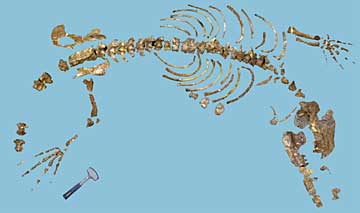
http://www.studyworksonline.com/cda/image/preview/0,1127,1309,00.jpg
It looks like they [Answers in Genesis] left out some of the fossil, doesn't it? Like the pelvis, and many of the vertebra. I wonder why they would do that.
It's misleading people, and misrepresenting the truth. There is no argument. They should remove that awful section from the web before somebody believes they're actually a scientific authority... and goes to debate that false information with people who know better.
You don't put a link to another page and say "Ooops, we deliberately and knowingly made an error, but we're not going to address or correct it."
A lie is a lie. (Link explaining it or not).
Explain it right on the page if you're going to put false information on the web.
The problem with the so-called explanation Answers in Genesis returned is that AiG is attempting to mislead people to believe these articles were written back in 1994.
Addendum 2 (4 January 2002)
Some evolutionists have tried to counter this paper by charging me with faking the information presented. There is no deceit (faking), or contradiction, in the article. As stated at the beginning of the article, the article on the web was originally
published in Creation Ex Nihilo Technical Journal (now simply [home/area/magazines/technical.asp ]TJ) in 1994,
What Sarfati is neglecting to tell people, is that in 2001, when he wrote the article:
http://www.answersingenesis.org/pbs_nova/0926ep2.asp he knew Ambulocetus' spine, leg and pelvis bones had been recovered five years before!
So, what does out of date information from way back in 1994 have to do with the information that was available to Sarfati in 2001, when he wrote this article addressing Evolution: Great Transformations a program which aired in 2001. Sarfati may very well have known about the recovery of Ambulocetus' pelvis, leg and backbones in 1996, but he rejected the information out of hand, and continued to refer to a journal from 1994, on purpose and that was to deceive visitors to their website. Answers in Genesis / Jonathan Sarfati would like to freeze the year 1994 in a bottle, and continue to reject the fossil recoveries made by Thewissen in 1996.
That sums up the problem.
Answers in Genesis deals with the issue by sending a URL which has nothing to do with the article located at:
http://www.answersingenesis.org/pbs_nova/0926ep2.asp
The problem I have with what AiG has done, is about ethics and standards in the scientific community.
Webmaster note:
Joe: "Is there a photograph available (not "an approximate computerised reconstruction, based on the fossil remains that do exist" as per image label) of a single complete Ambulocetus fossil in-situ? i.e. A complete fossil skeleton recovered from a single, non vertically or horizontally dispersed locus. This would end conjecture on the correct morphology.
Webmaster: How very sad that you have became confused by the image. Yes, it should have been made more clear.
A Symmetrical Simulation Thru Computer -vs-

Actually, this photograph is what you are viewing:
The REAL Photo :

What you are looking at, is in fact, the complete skeleton (at least theoretically using computer technology, in the "approximate computerised reconstruction, based on the fossil remains that do exist"). Emphasizing: the remains that DO EXIST. Utilizing Photoshop, and erasing all pixels of the Professor and laboratory and leaving ONLY the Ambulocetus natans fossil. Then, to provide a symmetrical reconstruction of what ambulocetus *should look like* by filling in, with a mirror image of the leg and arm bones that already exist. It is very sad that you were confused sir.
